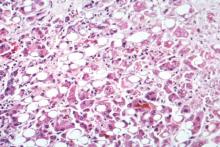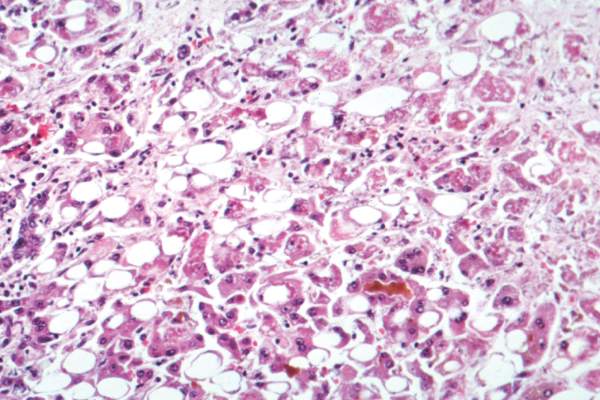User login
SAN FRANCISCO – The only patients with alcoholic hepatitis to derive a survival benefit from extracorporeal hepatocellular therapy with C3A hepatoma cells were those who were young and had low Model for End-Stage Liver Disease (MELD) scores, according to data from a randomized trial presented as a late breaker at the annual meeting of the American Association for the Study of Liver Diseases.
The evidence of benefit in younger patients was drawn from a post-hoc analysis of a negative late-breaker trial presented by Dr. David Reich, vice chair, department of surgery, Drexel University, Philadelphia. A new trial is now being planned to target this subgroup of patients.
In this multinational randomized trial, called VTI-208, 203 patients with alcoholic hepatitis were randomized to the experimental therapy or to a control arm. Those in the experimental arm received C3A hepatoma cells delivered continuously for 3-5 days by an extracorporeal liver assist device (ELAD) along with standard of care. Patients in the control arm received standard of care alone. The primary endpoint of this study, with 40 participating centers worldwide, was overall survival (OS).
In an intent-to-treat analysis, OS did not differ significantly for ELAD relative to standard of care (52.1% vs. 52.3%). However, when patients were stratified by baseline MELD score and age, there were trends for an OS advantage in those receiving ELAD over standard of care for MELD scores less than 28 (71% vs. 57%; P = .077) and for subjects with an age below the median (67% vs. 55%; P = .167).
When both factors were considered together (MELD score less than 28 and an age below the median), the advantage of ELAD over standard of care reached significance (100% vs. 76%; P = .006). This subgroup analysis was not prespecified in the trial design, making this difference hypothesis generating,
The findings “suggest that ELAD may be a favorable alcoholic hepatitis treatment modality in younger patients with sufficient renal function and less severe coagulopathy,” Dr. Reich reported. “A study to confirm the survival benefit in this population is in preparation and is scheduled to start in 2016.”
Entry criteria for this study included a MELD score less than 35, a bilirubin greater than 8 mg/dL, and no other serious concomitant disease. Of patients randomized, 120 had a MELD score less than 28 and 101 were below the median age.
The expectation of benefit from C3A hepatoma cells was derived from evidence that these express immunomodulatory proteins and growth factors support hepatocellular function, according to Dr. Reich. The difference in survival in the younger patients was observed at 91 days. Dr. Reich reported that survival was “fairly stable” after 100 days in all patient groups.
“Alcoholic hepatitis results from hepatic inflammation, oxidative damage, cholestasis, and apoptosis, all of which create a vicious cycle that leads to liver dysfunction and secondary organ failure associated with poor prognosis,” Dr. Reich explained. It was hoped that ELAD delivery of C3A cells could modify this process.
Further study in subgroups that may benefit are encouraged by the safety profile observed in this study. There were no significant differences in serious adverse events observed in the two study arms, Dr. Reich reported.
Dr. Reich reported a financial relationship with Neuwave and VTI Corporation, the sponsor of the randomized study.
SAN FRANCISCO – The only patients with alcoholic hepatitis to derive a survival benefit from extracorporeal hepatocellular therapy with C3A hepatoma cells were those who were young and had low Model for End-Stage Liver Disease (MELD) scores, according to data from a randomized trial presented as a late breaker at the annual meeting of the American Association for the Study of Liver Diseases.
The evidence of benefit in younger patients was drawn from a post-hoc analysis of a negative late-breaker trial presented by Dr. David Reich, vice chair, department of surgery, Drexel University, Philadelphia. A new trial is now being planned to target this subgroup of patients.
In this multinational randomized trial, called VTI-208, 203 patients with alcoholic hepatitis were randomized to the experimental therapy or to a control arm. Those in the experimental arm received C3A hepatoma cells delivered continuously for 3-5 days by an extracorporeal liver assist device (ELAD) along with standard of care. Patients in the control arm received standard of care alone. The primary endpoint of this study, with 40 participating centers worldwide, was overall survival (OS).
In an intent-to-treat analysis, OS did not differ significantly for ELAD relative to standard of care (52.1% vs. 52.3%). However, when patients were stratified by baseline MELD score and age, there were trends for an OS advantage in those receiving ELAD over standard of care for MELD scores less than 28 (71% vs. 57%; P = .077) and for subjects with an age below the median (67% vs. 55%; P = .167).
When both factors were considered together (MELD score less than 28 and an age below the median), the advantage of ELAD over standard of care reached significance (100% vs. 76%; P = .006). This subgroup analysis was not prespecified in the trial design, making this difference hypothesis generating,
The findings “suggest that ELAD may be a favorable alcoholic hepatitis treatment modality in younger patients with sufficient renal function and less severe coagulopathy,” Dr. Reich reported. “A study to confirm the survival benefit in this population is in preparation and is scheduled to start in 2016.”
Entry criteria for this study included a MELD score less than 35, a bilirubin greater than 8 mg/dL, and no other serious concomitant disease. Of patients randomized, 120 had a MELD score less than 28 and 101 were below the median age.
The expectation of benefit from C3A hepatoma cells was derived from evidence that these express immunomodulatory proteins and growth factors support hepatocellular function, according to Dr. Reich. The difference in survival in the younger patients was observed at 91 days. Dr. Reich reported that survival was “fairly stable” after 100 days in all patient groups.
“Alcoholic hepatitis results from hepatic inflammation, oxidative damage, cholestasis, and apoptosis, all of which create a vicious cycle that leads to liver dysfunction and secondary organ failure associated with poor prognosis,” Dr. Reich explained. It was hoped that ELAD delivery of C3A cells could modify this process.
Further study in subgroups that may benefit are encouraged by the safety profile observed in this study. There were no significant differences in serious adverse events observed in the two study arms, Dr. Reich reported.
Dr. Reich reported a financial relationship with Neuwave and VTI Corporation, the sponsor of the randomized study.
SAN FRANCISCO – The only patients with alcoholic hepatitis to derive a survival benefit from extracorporeal hepatocellular therapy with C3A hepatoma cells were those who were young and had low Model for End-Stage Liver Disease (MELD) scores, according to data from a randomized trial presented as a late breaker at the annual meeting of the American Association for the Study of Liver Diseases.
The evidence of benefit in younger patients was drawn from a post-hoc analysis of a negative late-breaker trial presented by Dr. David Reich, vice chair, department of surgery, Drexel University, Philadelphia. A new trial is now being planned to target this subgroup of patients.
In this multinational randomized trial, called VTI-208, 203 patients with alcoholic hepatitis were randomized to the experimental therapy or to a control arm. Those in the experimental arm received C3A hepatoma cells delivered continuously for 3-5 days by an extracorporeal liver assist device (ELAD) along with standard of care. Patients in the control arm received standard of care alone. The primary endpoint of this study, with 40 participating centers worldwide, was overall survival (OS).
In an intent-to-treat analysis, OS did not differ significantly for ELAD relative to standard of care (52.1% vs. 52.3%). However, when patients were stratified by baseline MELD score and age, there were trends for an OS advantage in those receiving ELAD over standard of care for MELD scores less than 28 (71% vs. 57%; P = .077) and for subjects with an age below the median (67% vs. 55%; P = .167).
When both factors were considered together (MELD score less than 28 and an age below the median), the advantage of ELAD over standard of care reached significance (100% vs. 76%; P = .006). This subgroup analysis was not prespecified in the trial design, making this difference hypothesis generating,
The findings “suggest that ELAD may be a favorable alcoholic hepatitis treatment modality in younger patients with sufficient renal function and less severe coagulopathy,” Dr. Reich reported. “A study to confirm the survival benefit in this population is in preparation and is scheduled to start in 2016.”
Entry criteria for this study included a MELD score less than 35, a bilirubin greater than 8 mg/dL, and no other serious concomitant disease. Of patients randomized, 120 had a MELD score less than 28 and 101 were below the median age.
The expectation of benefit from C3A hepatoma cells was derived from evidence that these express immunomodulatory proteins and growth factors support hepatocellular function, according to Dr. Reich. The difference in survival in the younger patients was observed at 91 days. Dr. Reich reported that survival was “fairly stable” after 100 days in all patient groups.
“Alcoholic hepatitis results from hepatic inflammation, oxidative damage, cholestasis, and apoptosis, all of which create a vicious cycle that leads to liver dysfunction and secondary organ failure associated with poor prognosis,” Dr. Reich explained. It was hoped that ELAD delivery of C3A cells could modify this process.
Further study in subgroups that may benefit are encouraged by the safety profile observed in this study. There were no significant differences in serious adverse events observed in the two study arms, Dr. Reich reported.
Dr. Reich reported a financial relationship with Neuwave and VTI Corporation, the sponsor of the randomized study.
FROM THE LIVER MEETING 2015
Key clinical point:Extracorporeal hepatocellular therapy with human C3A hepatoma cells did not provide an overall survival benefit in patients with alcoholic hepatitis.
Major finding: In a post hoc analysis of an otherwise negative trial, C3A cell infusion was only associated with a survival advantage in younger, healthier patients (100% vs. 73%; P = .006).
Data source: Randomized, multicenter trial.
Disclosures: Dr. Reich reported a financial relationship with Neuwave and VTI Corporation, the sponsor of the randomized study.

